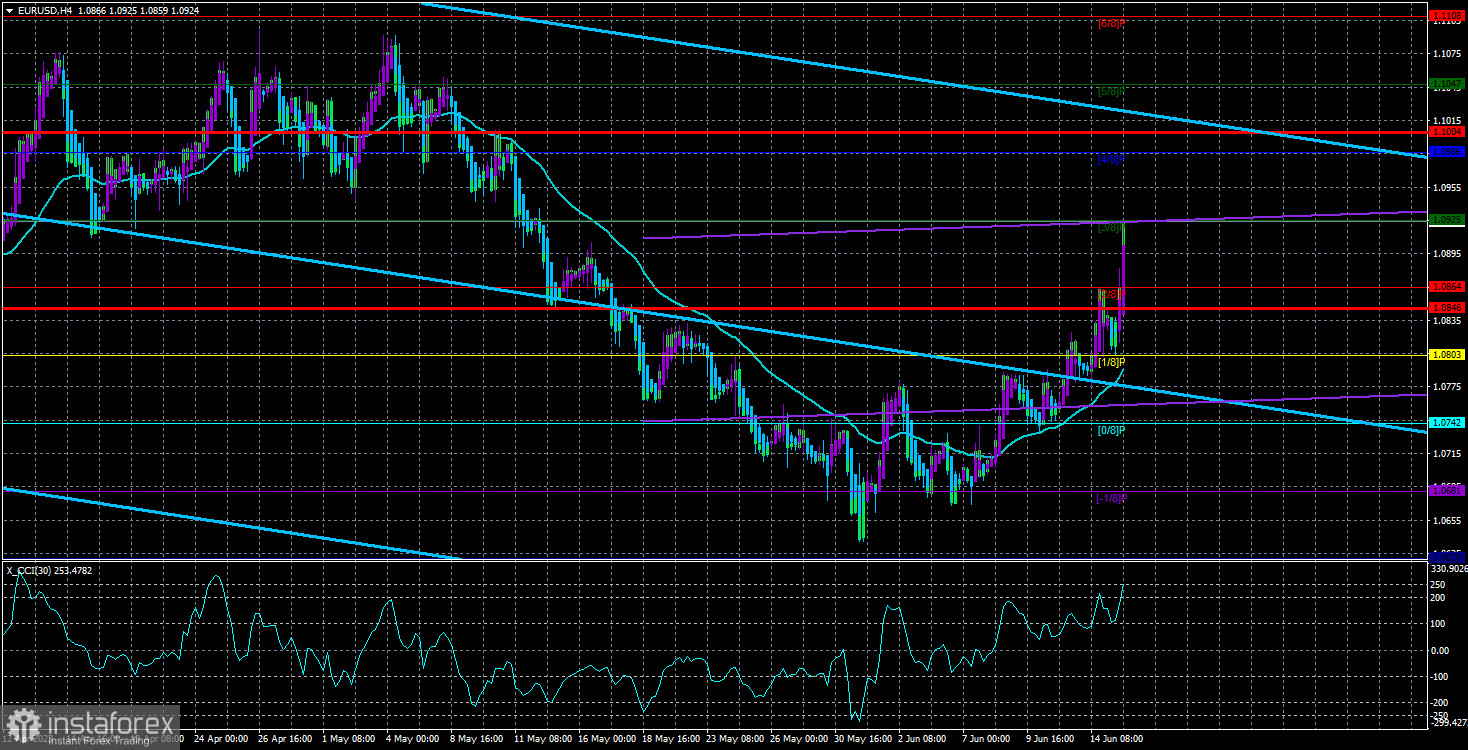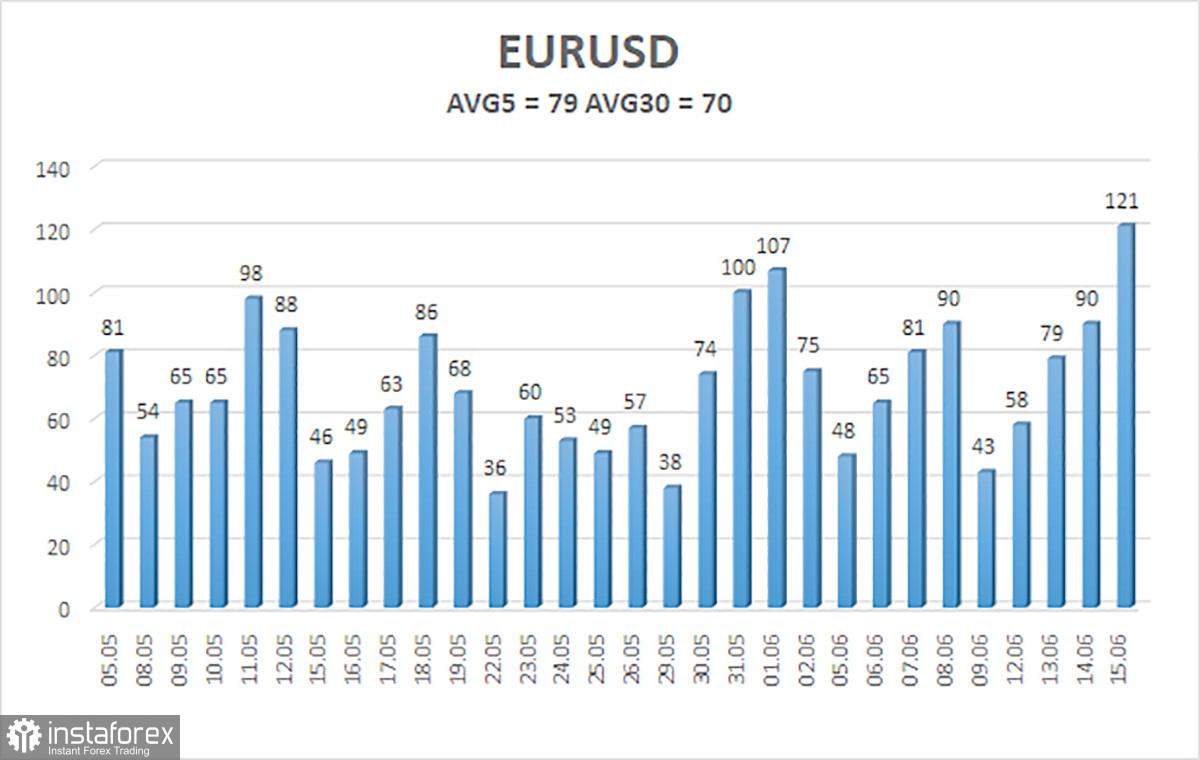
When the Federal Reserve (Fed) paused, and Jerome Powell's hints of two more rate hikes in 2023 became known, the dollar strengthened weakly but regained growth by Thursday morning, which continued for most of the day. Overall, we cannot say that the market reacted strangely to the Fed meeting and Powell's speech, but we still believe that the dollar could have shown a stronger rally.
It is worth noting that the euro and the pound are currently trading differently. The pound reached its recent long-term high just yesterday, while the euro is simply correcting against a downward trend and is ready to resume its decline at any moment. Despite the ECB having raised rates again and the Bank of England potentially doing so next week for the last time, the euro is still showing very weak growth (which is logical), while the pound is showing significant growth (which is illogical). Therefore, the euro looks much more attractive for trading than the pound.
A lot of macroeconomic data was published yesterday in the European Union and the United States. This included industrial production in both countries, overseas retail sales, jobless claims, and others. However, all these reports were overshadowed by the ECB and Fed meetings. Since the pair changed its direction several times during the day, it is difficult to determine which data the market reacted to and which did not. We always advise avoiding trading on such days or being very cautious. As we can see, it's for a good reason.
In the 24-hour timeframe, the pair consolidated within the Ichimoku cloud, allowing it to continue its growth. However, it now needs to overcome the Kijun-sen line, which is also strong. Nevertheless, one thing can be stated at the moment: we have not witnessed any significant correction in the long-term perspective.
The ECB raised all three rates for the eighth consecutive time
As we mentioned in yesterday's article, there is no point in expecting surprises from the European regulator. The rates predictably increased by another 0.25%, and this tightening may be the penultimate in the cycle. It is worth noting that three more hikes are expected after a central bank slows down the pace of tightening to a minimum. Certainly, there could be more hikes, but expecting the ECB to raise rates to 5% or 5.5% is unjustified. We have explained why, so there is no need to repeat it.
What's more interesting is the updated inflation forecasts by the ECB. They expect 5.4% inflation this year, 3% in 2024, and 2.2% in 2025. Thus, even after 2.5 years, the consumer price index is unlikely to return to the target value. If the ECB were determined to raise rates "to the bitter end" like the Fed, why were the inflation forecasts so weak? We believe the ECB's intentions to raise rates one more time can only be understood through their forecasts. Moreover, during the mortgage crisis in 2007-2008, the ECB's rate increased precisely to 4.25%. This value could be the "final stop" this time as well.
The ECB also published updated and lowered growth forecasts.
According to them, we can expect GDP growth of 0.9% in 2023 and 1.1% in the following year. Since the GDP forecasts have hardly changed (previously, they were only slightly higher by a few tenths of a percent), it also indicates the impending end of the tightening cycle. Based on all the arguments presented above, the euro has no grounds for a significant rally. The Fed may raise rates more strongly in the remaining part of 2023 than the ECB. And the Fed's rate is already much higher than the ECB's.

The average volatility of the euro/dollar currency pair for the last five trading days as of June 16 was 79 points, characterized as "average." Thus, we expect the pair to move between the levels of 1.0846 and 1.1004 on Friday. A downward reversal of the Heiken Ashi indicator will indicate the beginning of a downward correction.
Nearest support levels:
S1 - 1.0864
S2 - 1.0803
S3 - 1.0742
Nearest resistance levels:
R1 - 1.0925
R2 - 1.0986
R3 - 1.1047
Trading recommendations:
The EUR/USD pair continues to stay above the moving average line. It is advisable to remain in long positions with targets at 1.0986 and 1.1004 until the Heiken Ashi indicator reverses downward. Short positions will become relevant again only after the price securely falls below the moving average line, with targets at 1.0742 and 1.0681.
Illustration explanations:
Linear regression channels - help determine the current trend. If both channels point in the same direction, it indicates a strong trend.
Moving average line (settings 20.0, smoothed) - determines the short-term trend and the direction in which trading should be conducted.
Murray levels - target levels for movements and corrections.
Volatility levels (red lines) - probable price channel in which the pair will move in the next 24 hours, based on current volatility indicators.
CCI indicator - its entry into the oversold area (below -250) or overbought area (above +250) indicates an upcoming trend reversal in the opposite direction.
 English
English 
 Русский
Русский Bahasa Indonesia
Bahasa Indonesia Bahasa Malay
Bahasa Malay ไทย
ไทย Español
Español Deutsch
Deutsch Български
Български Français
Français Tiếng Việt
Tiếng Việt 中文
中文 বাংলা
বাংলা हिन्दी
हिन्दी Čeština
Čeština Українська
Українська Română
Română

